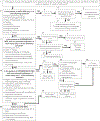Accidental trauma of infancy: emergency department evaluation and management
- PMID: 33560628
- PMCID: PMC11851635
Accidental trauma of infancy: emergency department evaluation and management
Abstract
The common mechanisms and injury patterns of accidental trauma in infants differ from those of older children and adults, with falls representing the most common etiology. While the evaluation of traumatic injury in infants should follow an algorithm similar to that used for adults, the unique pediatric physiologic response to trauma must be taken into consideration. In addition, the utility of certain imaging studies in these patients is highly case specific, particularly with minor head injuries. This supplement reviews the evaluation and management of infants with accidental traumatic injury, including the most common circumstances and pathophysiology of injury, the differential diagnosis of the infant trauma victim, and the workup and management of accidental injuries in this patient population.
Figures

References
-
- Magnuson D, Eichelberger M. Approach to the pediatric trauma patient. In: Oldham KT, Foglia RP, Colombani PM, eds. Surgery of Infants and Children: Scientific Principles and Practice. Philadelphia, PA: Lippincott-Raven Publishers; 1997:391–415. (Textbook chapter)
-
- Murphy SL, Xu J, Kochanek KD, et al. Deaths: final data for 2015. Natl Vital Stat Rep. 2017;66(6):1–75. (Statistical report) - PubMed
-
- Pickett W, Streight S, Simpson K, et al. Injuries experienced by infant children: a population-based epidemiological analysis. Pediatrics. 2003;111(4 Pt 1):e365–e370. (Retrospective; 990 patients) - PubMed
-
- Alwash R, McCarthy M. How do child accidents happen? Health Educ J. 1987;46(4):169–171. (Retrospective; 402 patients) - PubMed
-
- McCormick MC, Shapiro S, Starfield BH. Injury and its correlates among 1-year-old children. Study of children with both normal and low birth weights. Am J Dis Child. 1981;135(2):159–163. (Retrospective; 4989 patients) - PubMed
Publication types
MeSH terms
Grants and funding
LinkOut - more resources
Full Text Sources

